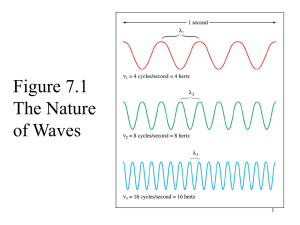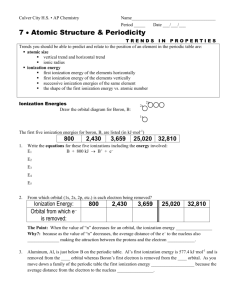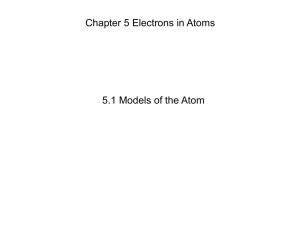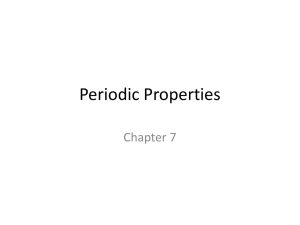R n,l
advertisement
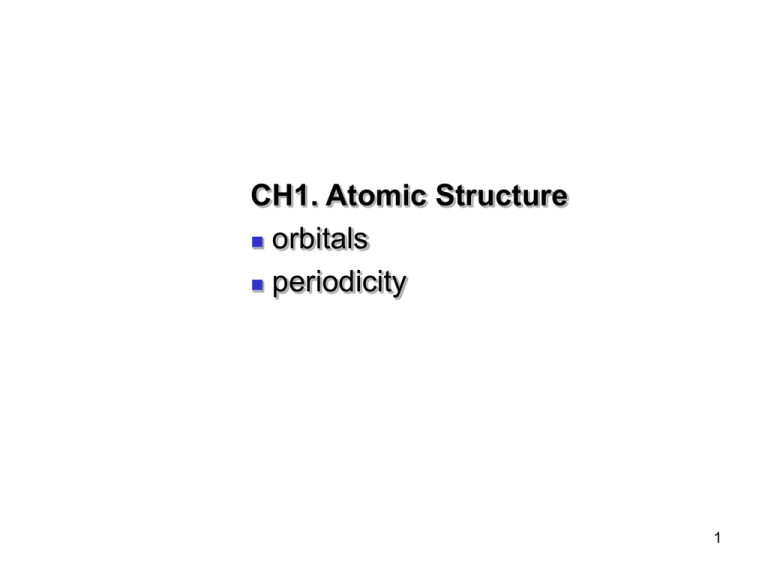
CH1. Atomic Structure orbitals periodicity 1 Schrodinger equation - (h2/2p2me2) [d2Y/dx2+d2Y/dy2+d2Y/dz2] + V Y = E Y h = constant me = electron mass V = potential E gives quantized energies E = total energy 2 Yn,l,ml (r,q,f) = Rn,l (r) Yl,ml (q,f) Rn,l(r) is the radial component of Y • n = 1, 2, 3, ...; l = 0 to n – 1 • integral of Y over all space must be finite, so R → 0 at large r Spherical coordinates 3 Rn,l (r) Orbital n l Rn,l for H atom 1s 1 0 2 (Z/ao)3/2 e-/2 2s 2 0 1 / (2√2) (Z/ao)3/2 (2 - ½) e-/4 = 2 Zr / na0 4 Radial Distribution Function RDF max (RDF) is the Bohr radius • R(r)2 is a probability function (always positive) • The volume increases exponentially with r, and is 0 at nucleus (where r = 0) • 4pr2R2 is a radial distribution function (RDF) that takes into account the spherical volume element 5 Yn,l,ml (r,q,f) = Rn,l(r) Yl,ml(q,f) Yl,ml (q,f) is the angular component of Y • ml = - l to + l • When l = 0 (s orbital), Y is a constant, and Y is spherically symmetric 6 Some Y2 functions When l = 1 (p orbitals) ml = 0 (pz orbital) Y = 1.54 cosq, Y2 cos2q, (q = angle between z axis and xy plane) xy is a nodal plane Y positive Y negative 7 Orbitals an atomic orbital is a specific solution for Y, parameters are Z, n, l, and ml • Examples: 1s is n = 1, l = 0, ml = 0 2px is n = 2, l = 1, ml = -1 8 Example - 3pz orbital From SA Table 1.2 for hydrogenic orbitals; n = 3, l = 1, ml = 0 Y3pz = R3pz . Y3pz Y3pz = (1/18)(2p)-1/2(Z/a0)3/2(4 - 2)e-/2cosq where = 2Zr/na0 9 Some orbital shapes Atomic orbital viewer 10 Orbital energies For 1 e- (hydrogenic) orbitals: E = – mee4Z2 / 8h2e02n2 E – (Z2 / n2) 11 Many electron atoms • with three or more interacting bodies (nucleus and 2 or more e-) we can’t solve Y or E directly • common to use a numerative self-consistent field (SCF) • starting point is usually hydrogen atom orbitals • E primarily depends on effective Z and n, but now also quantum number l 12 Shielding • e- - e- interactions (shielding, penetration, screening) increase orbital energies • there is differential shielding related to radial and angular distributions of orbitals • example - if 1s electron is present then E(2s) < E(2p) 13 Orbital energies 14 Effective Nuclear Charge shielding parameter • • • • Zeff = Z* = Z - s SCF calculations for Zeff have been tabulated (see text) Zeff is calculated for each orbital of each element E approximately proportional to -(Zeff)2 / n2 15 Table 1.2 16 Valence Zeff trends s,p 0.65 Z / e- d 0.15 Z / e- f 0.05 Z / e- 17 Electron Spin • • ms (spin quantum number) with 2 possible values (+ ½ or – ½). Pauli exclusion principal - no two electrons in atom have the same 4 quantum numbers (thus only two eper orbital) 18 Electronic Configurations Examples: • Ca (Z = 20) ground state config. 1s2 2s2 2p6 3s2 3p6 4s2 or just write [Ar]4s2 • N (Z = 7) 1s2 2s2 2p3 [He] 2s22p3 actually [He] 2s22px1 2py1 2pz1 19 Multiplicity • Hund's rule of maximum multiplicity – atom is more stable when electron's correlate with the same ms sign • This is a small effect, only important where orbitals have same or very similar energies (ex: 2px 2py 2pz, or 4s and 3d) • S = max total spin = the sum adding +½ for each unpaired electron • multiplicity = 2S + 1 20 1st row transition metals 3d half-filled 3d filled # unpaired e- multiplicity Sc [Ar]3d14s2 1 2 Ti [Ar]3d24s2 2 3 V [Ar]3d34s2 3 4 Cr [Ar]3d54s1 6 7 Mn [Ar]3d54s2 5 6 Fe [Ar]3d64s2 4 5 Co [Ar]3d74s2 3 4 Ni [Ar]3d84s2 2 3 Cu [Ar]3d104s1 1 2 Zn [Ar]3d104s2 0 1 21 Ionic configurations • • Less shielding, so orbital E’s are ordered more like hydrogenic case, example: 3d is lower in E than 4s TM ions usually have only d-orbital valence electrons, dns0 Fe (Z = 26) Fe is [Ar]3d64s2 But Fe(III) is [Ar]3d5 4s0 22 Atomic Orbitals - Summary Y (R,Y) • RDF and orbital shapes • shielding, Zeff, and orbital energies • electronic configurations, multiplicity 23 Periodic Trends • • • • • Ionization Energy ( I ) Electron Affinity (Ea) Electronegativity (c) Atomic Radii Hardness / Softness 24 Ionization energy • • • Energy required to remove an electron from an atom, molecule, or ion I = DH [A(g) → A(g)+ + e- ] Always endothermic (DH > 0), so I is always positive 25 Ionization energy • • • Note the similarity of trends for I and Zeff, both increase left to right across a row, more rapidly in sp block than d block Advantage of looking at I trend is that many data are experimentally determined via gas-phase XPS But, we have to be a little careful, I doesn't correspond only to valence orbital energy… 26 Ionization energy • I is really difference between two atomic states • Example: N(g) → N+(g) + epx1py1pz1 → 2px12py1 mult = 4 → mult = 3 vs. O(g) → O+(g) + epx2py1pz1 → px1py1pz1 mult = 3 → mult = 4 Trend in I is unusual, but not trend in Zeff 27 Ionization energy Molecular ionization energies can help explain some compounds’ stabilities. I can be measured for molecules cation NO NO2 I (kJ/mol) 893 NOAsF6 940 NO2AsF6 CH3 O2 OH N2 950 1165 1254 1503 CH3SO3CF3, (CH3)2SO4 O2AsF6 HOAsF6 N2AsF6 DNE 28 Electron affinity • • • • • Energy gained by capturing an electron Ea = – DH [A(g) + e- → A-(g)] Note the negative sign above Example: DH [F(g) + e- → F- (g)] = - 330 kJ/mol Ea(F) = + 330 kJ/mol (or +3.4 eV) notice that I(A) = Ea(A+) I = DH [A(g) → A+(g) + e-] 29 Electron affinity • • • Why aren’t sodide A+ Na- (s) salts common ? Periodic trends similar to those for I, that is, large I means a large Ea Ea negative for group 2 and group 18 (closed shells), but Ea positive for other elements including alkali metals: DH [Na(g) + e- → Na-(g)] ≈ - 54 kJ/mol Some trend anomalies: Ea (F) < Ea (Cl) and Ea (O) < Ea (S) these very small atoms have high edensities that cause greater electronelectron repulsions 30 Electronegativity Attractive power of atom or group for electrons Pauling's definition (cP): A-A bond enthalpy = AA (known) B-B bond enthalpy = BB (known) A-B bond enthalpy = AB (known) If DH(AB) < 0 then AB > ½ (AA + BB) AB – ½ (AA + BB) = const [c(A) - c(B)]y Mulliken’s definition: cM = ½ (I + Ea) 31 Atomic Radii Radii decrease left to right across periods • Zeff increases, n is constant • Smaller effect for TM due to slower increase Zeff • (sp block = 0.65, d block = 0.15 Z / added proton) 32 Atomic Radii • • X-ray diffraction gives very precise distances between nuclei in solids BUT difficulties remain in tabulating atomic or ionic radii. For example: • • • He is only solid at low T or high P, but all atomic radii change with P,T O2 solid consists of molecules O=O........O=O P(s) radius depends on allotrope studied 33 Atomic radii - trends • Radii increase down a column, since n increases lanthanide contraction: 1st row TM is smaller, 2nd and 3rd row TMs in each triad have similar radii (and chemistries) Why? Because 4f electrons are diffuse and don't shield effectively Period Group 5 Group 8 Group 10 4 V 1.35 Å Fe 1.26 Ni 1.25 5 Nb 1.47 Ru 1.34 Pd 1.37 6 Ta 1.47 Os 1.35 Pt 1.39 34 Hardness / Softness • • • hardness (h) = ½ (I - Ea) h prop to HOAO – LUAO gap large gap = hard, unpolarizable small gap = soft, polarizable polarizability (a) is ability to distort in an electric field 35
